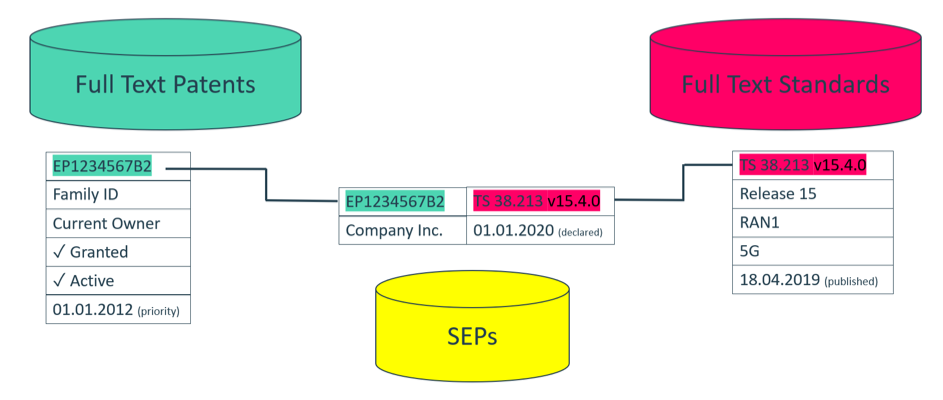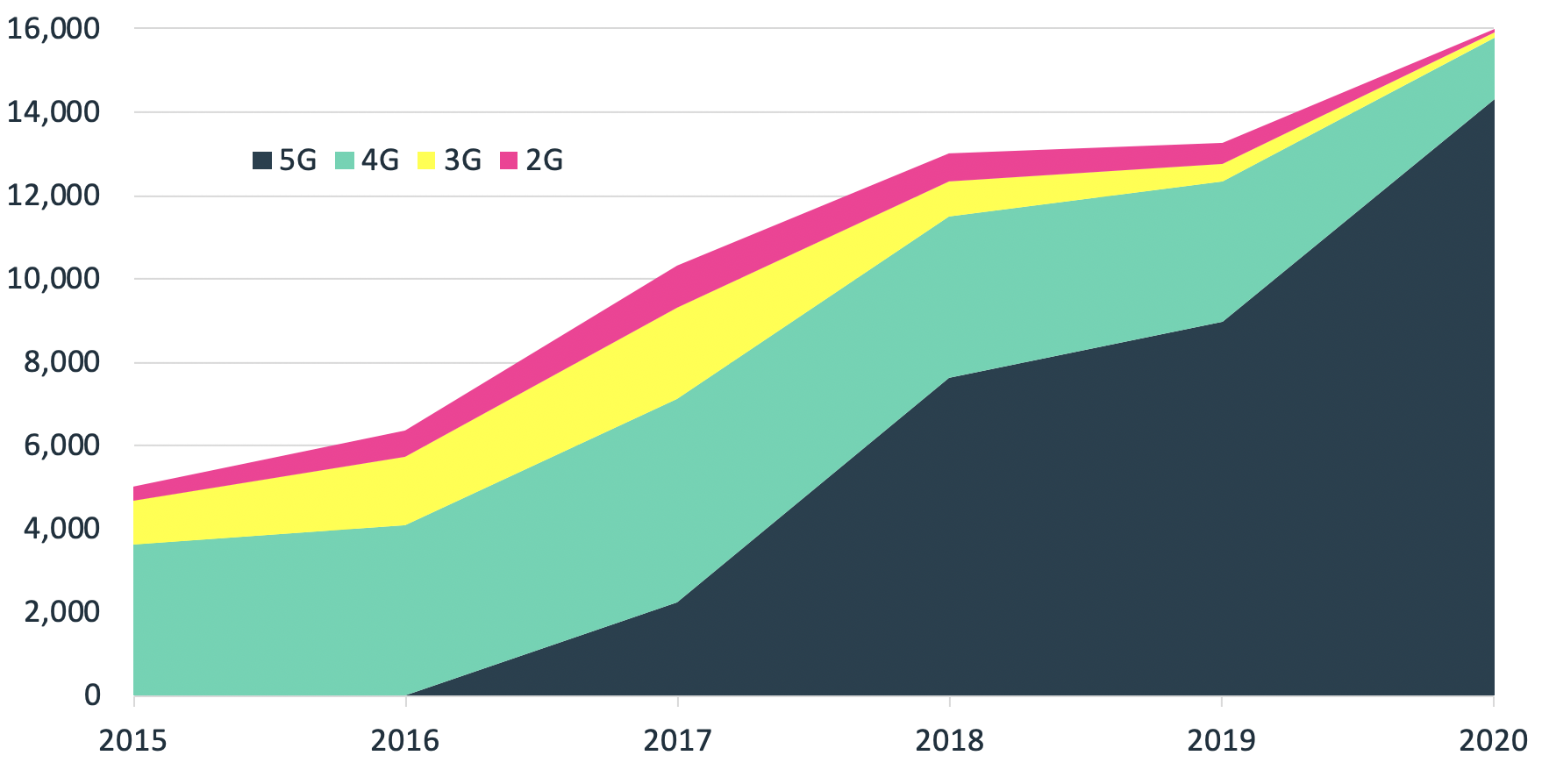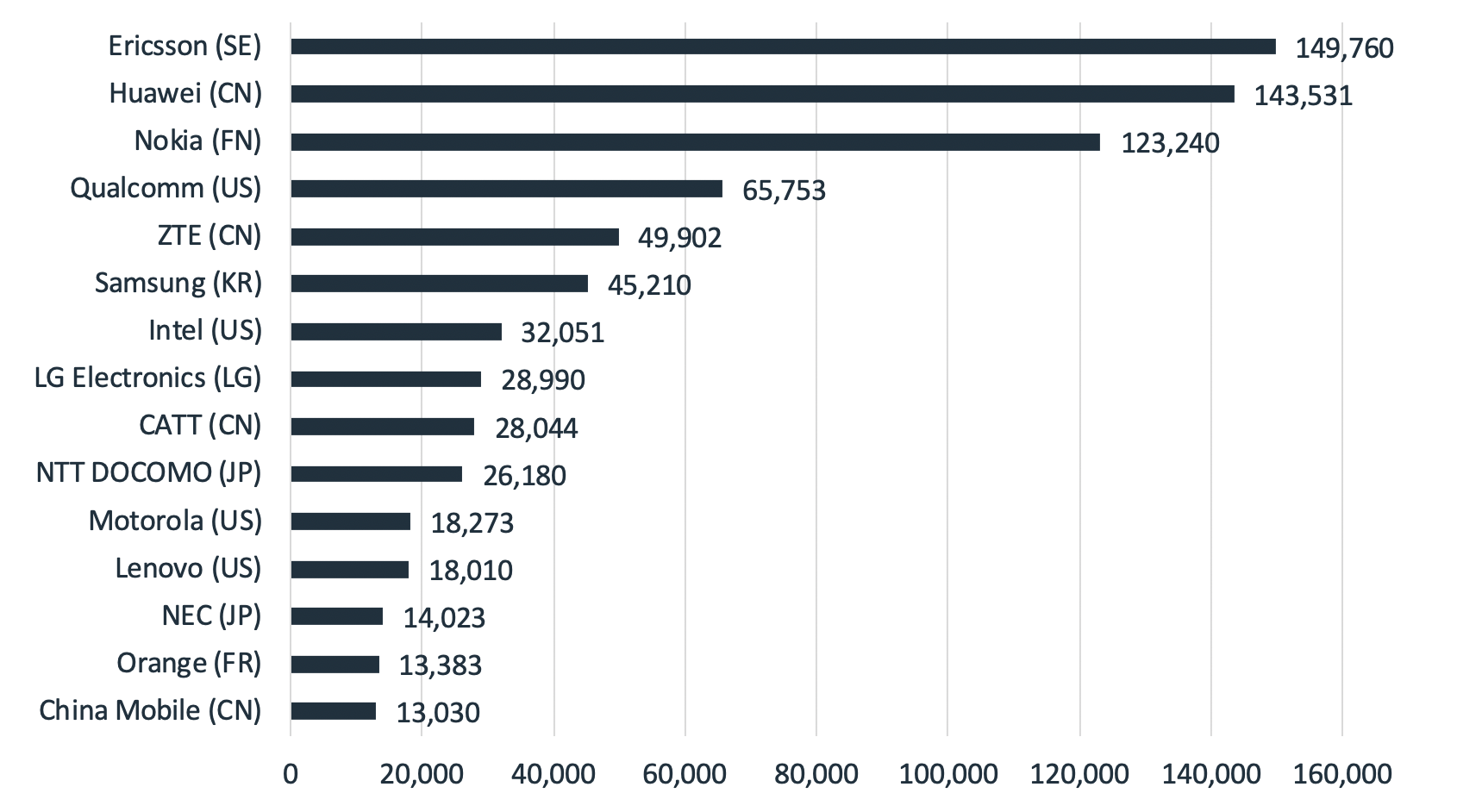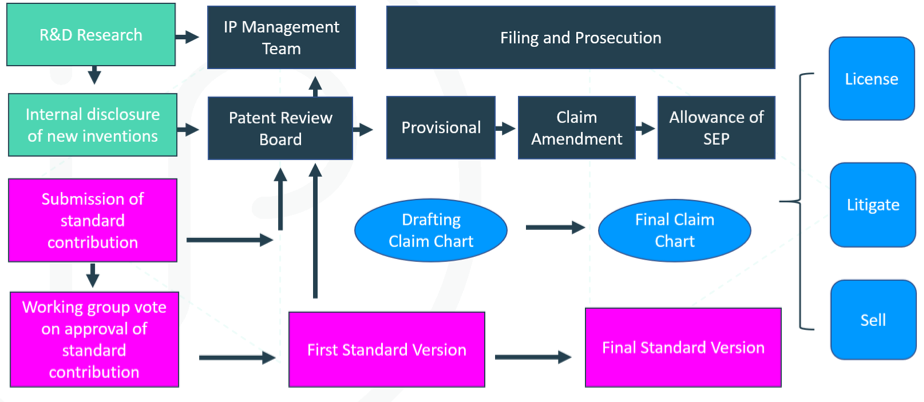“As future technologies that enable connectivity will increasingly rely on patented technology standards, IP professionals should not only consider information retrieved from patent filing data, but also analyze standardization data, such as patent declarations and standards contributions.”
With multiple reports published by many different entities on 5G leadership, it is hard to know who to believe, as there is little transparency about where the data comes from and what types of analysis were applied to retrieve the results, let alone how to try to reproduce any such analysis yourself. Most of the time, understanding standard essential patents (SEPs), standards and patents requires access to multiple databases, the valuable time of your subject matter experts, as well as both in-house and outside counsel. In the end, it can appear that you are spending far more resources on gathering the data than on gaining actionable knowledge from it to understand what it means to your business, your portfolio and your strategy.
Counting 5G Declared Patents
One of the major challenges when licensing, transacting, or managing SEPs is that there is no public database that provides information about verified SEPs. SEP declaration databases are meant to document fair, reasonable and non-discriminatory (FRAND) obligations and are not maintained to provide an accurate landscape of verified SEPs.
Standard-setting organizations (SSOs) such as ETSI (4G/5G) encourage standards developers to declare any patent that could potentially be essential for standards. Some declaring companies conduct patent claim mapping against the standard before declaring patents; others declare any potential patent without in-depth analysis. Often, companies submit patent declarations when patents are still pending and the standard is still evolving. Thus, patent claims as well as standards specifications are likely subject to change after the declaration has already been submitted. By design of these declaration practices, some of these patents end up being not essential.
Other declaration databases, such as IEEE (Wi-Fi) and ITU (HEVC/VVC) allow for the submission of so-called blanket declarations, where declaring companies need not declare specific patent numbers but only submit a blanket statement without any further details about potentially essential patents. By design of the blanket declaration practice, these databases provide no information about the magnitude of SEP ownership across companies. Thus in the case of blankets, there is no transparency about a declaring company owning, for example, one SEP or several thousands.
This creates two situations:
The ‘Maximal Declaration’ Situation
- According to expert reports, approximately 10-47% of all ETSI declared 2G/3G/4G patents can be verified as essential patents (Unwired Planet v. Huawei, TCL v. Ericsson).
The “Minimal Declaration” Situation
- According to expert reports, approximately 10-20% of all Wi-Fi SEPs are declared at IEEE (estimations in Microsoft Corp. v. Motorola, Inc.).
- According to expert reports, approximately 20-30% of all HEVC SEPs are declared at ITU-T (comparing MPEG LA and Access Advance pooled HEVC SEPs).
The numbers quoted above are examples of subject matter expert reports and may vary when considering other reports. No matter what the percentages are, all reports show that patent declaration databases either include non-essential patents (e.g. ETSI and others) or are incomplete (e.g. IEEE, ITUT and others), which means SEP information is missing.
SEP declaration databases are, however, the best publicly available source and often function as the starting point to understand SEP ownership. To identify 5G patents, the IPlytics Platform integrates all European Telecommunications Standards Institute (ETSI) declared patents (as to the yellow marked database in figure 1) and matches these to worldwide patent information (green marked in figure 1) and the 3GPP standards database (pink marked in figure 1).

Figure 1: Cross-correlating SEP declarations with worldwide patents and standards data
Declared patents typically provide information on the relevant technical specification (TS) number the patent is allegedly essential for. The TS number and version allow for retrieving information about the technical generation of the standard, as well as the standard subgroup, the standard release and the date of standard publication.
- Standards generation (2G, 3G, 4G, 5G)
- Standard technology groups to e.g. differentiate between user equipment (RAN1, RAN2, RAN4, SA2, SA3, SA4 and CT1) and network infrastructure (e.g., RAN3)
- Standard release number (e.g. Release 14, 15 or 16)
- Standard publication date allows understanding the possible date of product implementation.
On the other hand, declared patent numbers allow for pulling information such as:
- Current owner (first applicant, re-assignments)
- Status (granted, pending, revoked, active, lapsed, expired)
- Family ID (extended INPADOC, simple family)
- Dates (priority date, filing date, grant date, expiration date)
To identify patent declaration trends over time, the IPlytics database was utilized to count 5G declared patent families as to the year of declaration (figure 2). The analysis considers all patent declarations published at ETSI between 2015-2020. Patent declarations were classified as relevant to 2G/3G/4G/5G generation by cross correlating the declared TS with the ESTI and 3GPP standard data (figure 1). Patent declarations were also marked as, for example, 4G or 5G if the project description of the declaration document contained information for standard projects describing ‘LTE‘, ‘4G‘, ‘New Radio’ or ‘5G’. Since patents can be essential across standard generations, patent declarations previously declared to, for example, 2G, 3G or 4G, and then again declared for 5G, were counted several times for each generation. All counts are based on the INPADOC extended patent family definition.

Figure 2: 5G declared patent families as to the year of declaration (IPlytics Platform)
Counting 5G Standards Contributions
Another approach for assessing the strength of 5G leadership is to analyze the involvement of companies in the development of the 5G standard. This approach assumes that companies with the greatest influence on the 5G standard will also have the strongest 5G patent portfolios of the future. To identify leadership in standards development, the IPlytics database was used to count the number of 2G/3G/4G/5G contributions submitted per company (figure 3).
While standards contributions differ in their impact on innovation and are not intended to provide ownership of the standard, analyzing these contributions is a way to assess the involvement and investment of companies in the development of connectivity standards such as 5G. The development of these standards is carried out in standards consortia and, in the case of 5G, at the 3GPP (3rd Generation Partnership Project). These kinds of consortia are contribution-based, which means that member companies can submit technical proposals for inclusion in the standard, which are put to a vote. The final specifications have therefore been reviewed by hundreds of global experts, who usually work for companies that are competitors in the market. Standards consortia are therefore both collaborative and highly competitive. Further, it requires considerable research and investment to make technically meaningful and convincing contributions. Companies can only gain credibility in standards consortia by regularly participating and developing the best specifications, which allows them to bring their own developed and (sometimes) patented technologies into the standard. The counting and analysis of submitted contributions thus demonstrates how much share and influence companies have in standards development.

Figure 3. Submitted contributions at 3GPP submitted for 2G, 3G, 4G and 5G between 1998-2021 per company (IPlytics Platform)
Standards consortia publish all contributions of its members. The parsing of contribution documents allows the associations of the standard contributions and the companies that have submitted the proposal. While the ranking in figures 3 provides a first overview about the strongest standards developers as to the total number of submitted contribution documents, contribution data must be refined and well understood to make sense of the contribution counting. As such, contributions can be divided into:
- type (eg, work item, change request, input, output document or draft);
- category (eg, addition of feature, correction or editorial or functional modification); and
- status (eg, agreed, approved, incorporated, noted, or rejected).
The type of contribution demonstrates the magnitude of how the contribution influences the final standard. For example, a work item represents an initial idea for a new standard specification, while a change request suggests a change to an existing standard project. The category defines whether the contribution is about a new proposed technical feature or a formal correction. When counting contributions as indicators for technical leadership, it is for example vital to exclude non-technical categories. Finally, contributions must go through a review process where the members of standard working groups vote and decide on approving and incorporating a contribution. To technically cluster contribution one can further relate contributions to technology generations, such as 2G, 3G, 4G or 5G. Also, contributions originate from standards working groups that typically collaborate in a working group that develop specific technology topics and finally contributions are published throughout different releases:
- generation (3G, 4G, 5G, Wi-Fi 4, Wi-Fi 5, Wi-Fi 6, AVC, HEVC, VVC);
- group (RAN 1, RAN 2, SA 1, SA2, CT1, TGax, TGn, TGbe, JVT, JCTVC, JVET); and
- release (eg, Release 12, 13, 14, 15, 16)
Due to the collaborative and iterative aspects of standard setting, contributions are often submitted by a group of companies. Typically, one company is the main contributor of the proposal and has peer companies to join and promote the contribution. In this case, the first contributor is the company that provides most of the technology, with the others commenting on and supporting it. That is why one must differentiate between the first contributing company (ie, leader of the pack that initiated the contribution and may contribute the larger technical input) and the supporting contributing company (ie, supporting organization that agrees and supports but may provide little input).
Contribution data is especially important in cases where patent declaration databases for certain standards (eg, Wi-Fi or video compression (eg, HEVC or VVC)) are incomplete. Counting standards contributions allows us to understand who will likely own SEPs when companies do not publicly disclose them in the standards bodies SEP declaration databases.
Standards Contributions as Means to File Essential Patents
Market leaders in the telecoms industry often strategically align standards development and the submission of standards contributions with R&D efforts, patent prosecution processes, portfolio development, patent licensing and patent transaction practices. The early filing of provisional applications allows standards developers to protect contributions before they are submitted. These contributions – when approved by the working group – are then vital means to integrating patented inventions into the final standards specification. Figure 4 well describes how R&D teams (marked green), standard developing teams (marked pink) as well as the patent board and the patent prosecution team (marked dark blue) must strategically work together to ensure filing not only essential but also valid standard essential patents.

Figure 4. Cross departmental efforts to filing valid and essential SEPs
Figure 4 well illustrates the process of how an invention disclosed by the R&D team is decided for patent filing with the patent board, to then carry this priority application to the standard development team. The standards developers introduce and submit the patented solution as a standard contribution. However, as the standard is subject to constant changes the patent prosecution team must align claim language to ensure that the invention can be mapped to the latest standard version, while at the same time ensuring no prior art exists. Claim amendment allows changing claims until the patent is issued, making sure the granted patent can be charted to the latest standard version.
Best Practices on SEP Declaration and Standards Contribution Counting
As future technologies that enable connectivity will increasingly rely on patented technology standards, IP professionals should not only consider information retrieved from patent filing data, but also analyze standardization data, such as patent declarations and standards contributions. This allows one to strategically align patent portfolios to protect innovations and proactively engage in continuous strategic portfolio development as it relates to SEP assets, for initiatives such as licensing, acquisitions and joining patent pools, or to understand the respective positions of the competition. The next technology revolution will connect everything, making it even more challenging to understand how technologies and IP rights overlap. In this regard, IP professionals need to rethink – even revolutionize – how to approach both patent and standards data, to provide business-ready insights for actionable decision making across the organization.
An upcoming IPWatchdog webinar will discuss and elaborate about best practices to Unpack 5G SEPs and standards contribution data to understand who holds the leadership position for declared SEPs in 5G and how leadership has changed with ongoing standards development over time. The webinar will further identify similarities and differences in declared SEP top portfolio owners between 4G and the new 5G to understand what 3GPP contribution data can tell us about SEP portfolio leaders for 4G and 5G. Another upcoming IPWatchdog webinar will talk about Challenges, Benefits & Solutions for Determining Essentiality for Standard Essential Patents. A panel of speakers will discuss why using algorithmic-based techniques for essentiality rates and patent essentiality prediction can get us even closer to knowing what is truly essential for 5G or 4G without draining our time or our resources.

![[IPWatchdog Logo]](https://ipwatchdog.com/wp-content/themes/IPWatchdog%20-%202023/assets/images/temp/logo-small@2x.png)

![[Advertisement]](https://ipwatchdog.com/wp-content/uploads/2024/04/Patent-Litigation-Masters-2024-sidebar-early-bird-ends-Apr-21-last-chance-700x500-1.jpg)

![[Advertisement]](https://ipwatchdog.com/wp-content/uploads/2021/12/WEBINAR-336-x-280-px.png)
![[Advertisement]](https://ipwatchdog.com/wp-content/uploads/2021/12/2021-Patent-Practice-on-Demand-recorded-Feb-2021-336-x-280.jpg)
![[Advertisement]](https://ipwatchdog.com/wp-content/uploads/2021/12/Ad-4-The-Invent-Patent-System™.png)







Join the Discussion
One comment so far.
Menno Treffers
May 16, 2021 05:58 amCounting standards contributions is a great way to get insight into the probability that a company’s patent portfolio contains SEPs. SEPs are often inventions that were created to solve a problem that is discovered while the standard is developed by the SDO.
Looking at the list of declared patents can give a distorted picture. As pointed out by Tim, only a small percentage can be verified as essential patents. That small percentage still include patents that will not survive litigation, for example because of prior art, or because infringement by the litigated product cannot be proven.
It would interesting to look at SEPs that end up being used by the patent owner in litigation against a product that implements the standard. That ought to be possible for litigation in the US. For other countries data on litigated patents is less readily available.